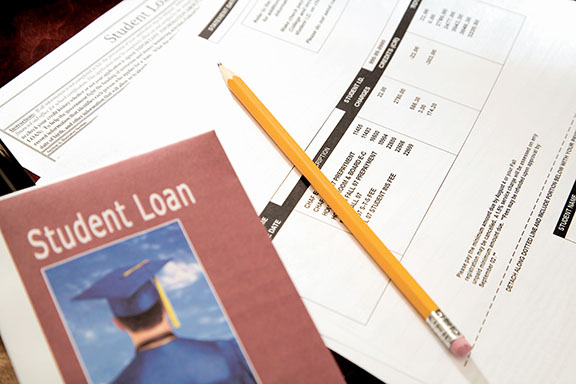
By Sunayana Prabhu
The relief is evident, but remorse is equally palpable.
President Joe Biden’s student loan forgiveness plan, nonetheless, is profoundly good news for many in the Two River community.
Biden announced Wednesday, Aug. 24, in a press statement from the White House that the U.S. Department of Education will cancel up to $20,000 in student debt for certain loan recipients, extend the student loan repayment pause and work to make the student loan system more manageable for future borrowers.
The Federal Student Aid website studentaid.gov has resources listing who qualifies for debt relief and how to apply.
Middletown resident Chris Miceli calls the debt cancelation plan “life-changing.” Miceli graduated with a degree in business administration from Georgian Court University and explained that he currently owes around $40,000 in federal student loans. With the $20,000 Pell Grant cancelation, half his debt will be forgiven. “I’m older, I’m 37,” Miceli said, and debt cancelation “really relieves the stress for me when I’m looking for new jobs.” Miceli said he can now think about using his money for his future, “like owning an apartment or house,” things that will significantly improve his quality of life.
According to the relief plan, borrowers with an individual income of less than $125,000 ($250,000 for married couples) are eligible for the debt relief. No high-income individual or high-income household – in the top 5% of incomes – will benefit from this action. The Institute of Student Loan Advisors is a nonprofit that offers “fair, free student loan advice.” It has a list of loans that are eligible for forgiveness, including Stafford, PLUS and consolidation loans, and defaulted federal family education loan program loans. State loans, private loans and fully paid loans do not qualify for the relief plan. Current students will only be eligible for relief if their loans originated before July 1, 2022.
Lauren Dominguez, a Red Bank resident, did not qualify for a Pell Grant because her “parents had too much money,” she said. Instead, she applied for and received a federally backed, private loan.
“I actually called my loan broker, my loan office, and Navient and Sallie Mae are not” eligible for debt relief, she said, noting that even if she declared bankruptcy, those loans “would never go away.”
Dominguez works part-time as a barista; she graduated in 2007 with a bachelor’s degree in English and is “still paying for it.”
“College costs are so outrageous,” said Susan Moore from Monmouth Beach. With three kids going through graduate school, she said, “The real problem is how expensive college education is.”
“Every year the tuition and costs go up far higher than cost of living goes up. I don’t know why it’s happening. I don’t know why government is allowing it to happen. Those kids that aren’t lucky enough to get substantial financial aid are paying,” Moore said.
According to the Federal Student Aid website, “Nearly 8 million borrowers may be eligible to receive relief automatically because their relevant income data is already available to the U.S. Department of Education.” For others, a “simple application process for borrowers to claim relief” will be available by early October. Borrowers can sign up online at ed.gov/subscriptions to receive updates from the U.S. Department of Education.
The average student loan balances at Monmouth University in West Long Branch are in the “$25-30,000 range,” said Robert Scott, Ph.D., professor in the Department of Economics, Finance & Real Estate, Leon Hess Business School. While the announcement is a relief for many, Scott understands the resentment from those who will not be benefiting from the program.
“I think part of the anger, too, is the fact that this doesn’t solve the underlying problem. The underlying problem is that college is extremely, incredibly expensive. And the student loan market is really a failed market,” Scott said.
The Department of Education published a Federal Student Loan Portfolio by Borrower Location on its website. As of March 31, 2022, about 1.2 million New Jersey residents held $43 billion in student loan debt, one of the highest amounts in the country.
While costs of college have skyrocketed, federal support has not kept pace. According to Scott, the student loan market doesn’t really work the way it did when it was established in the 1960s. “Loan forgiveness doesn’t fix inefficiencies in the market,” he said. “People are just going to take on more debt. We’re just going to be back in the same situation in a couple of years.”
Scott explained that getting rid of the debt, fixing issues with the student loan market, while also addressing the price of higher education, would go a long way toward correcting the problem. “But just fixing the debt piece without fixing the college cost piece of it just means that you’re kind of kicking the can down the road.”
As part of the current debt forgiveness plan, the administration is also offering Public Service Loan Forgiveness (PSLF). Borrowers employed by nonprofits, the military, or federal, state, tribal or local government may be eligible to have all of their student loans forgiven through the PSLF program. The website pslf.gov has more information on requirements and eligibility.
The pause on student loan repayments which began during the pandemic will be automatically extended through Dec. 31, 2022. Borrowers should expect to resume payment in January 2023.
Biden is also set to propose capping the amount borrowers pay monthly on undergraduate loans at 5% of their earnings.
Although she appreciates an extension on the pandemic loan freeze, Melissa Yetka of Keyport, an occupational therapist, said the demand for advanced degrees sets up financial failure when jobs don’t pay well. “I think there is a push for a lot of people to keep getting these advanced degrees and then just racking up more debt. So, we’re just set up for failure financially.”
She advised students to look into “trade jobs where you don’t necessarily need to get an education, or it doesn’t cost as much.”
Monmouth University’s Scott pointed out that many people “don’t spend their education dollars as judiciously as they should.” He suggested low-cost education options like community colleges and “the New Jersey STARS program that a lot of students are eligible for.”
The New Jersey Student Tuition Assistance Reward Scholarship program is an initiative created by the state to provide New Jersey’s highest achieving students with free tuition at their home county college. For families that have a hard time affording a “traditional four-year college degree, two years at a community college at a low cost or no cost, combined with two years or less at a state institution or somewhere that’s less expensive, is absolutely going to be the way to go,” said Scott.
Other online resources that could be helpful in managing student debt are debt.org and the American Education Services website aessuccess.org that services Federal Family Education Loan Program and private student loan products for lending partners throughout the nation.
Maureen Menkens, a Shrewsbury resident, has four grandchildren struggling with student loans in the range of $50,000 to $75,000. Although $10,000 is a small amount, she’s positive about Biden’s initiative. “It certainly is a start.”
Meanwhile, the Federal Trade Commission has already published a report on its website alerting consumers about debt relief scammers, much like credit card scammers. In its press statement the White House urged borrowers to sign up on studentaid.gov/debtrelief to receive further notifications. Scam calls can be reported to the Federal Trade Commission on its website ftc.gov.
The article originally appeared in the September 1 – 8, 2022 print edition of The Two River Times.














